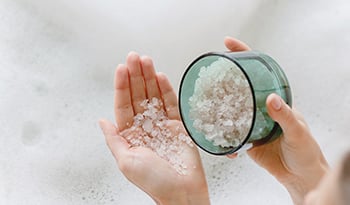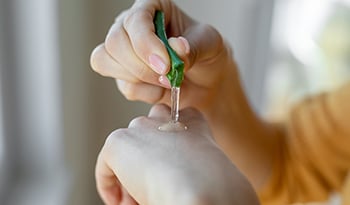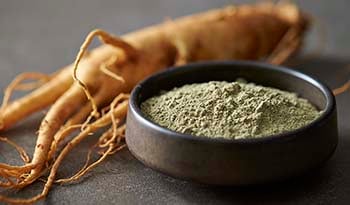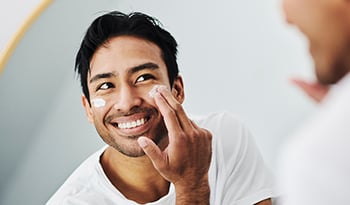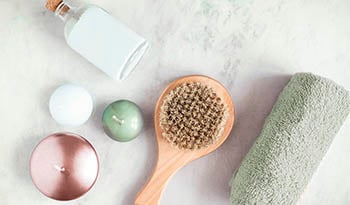All About Ceramides in Skincare

The demand for ceramides in skincare products has been growing each year, and not without good reason. Ceramides are a key component in our skin’s natural ability to maintain a healthy barrier and optimal hydration levels. However, to truly understand what ceramides are and what they can do when added to your skincare routine, we first have to dig a little deeper into the science.
The Role of Ceramides
One of the key roles that the skin plays in our body is in maintaining a protective “wall” against the outside world. The superficial layer of the skin (the epidermis) is made up of skin cells (keratinocytes) that replicate and mature as they grow outward. When they reach the outermost layer of the skin (the stratum corneum), they are referred to as corneocytes, which are dead cells that are packed with skin proteins (keratin).
These corneocytes are encased within a waxy, fatty (lipid) substance that forms a protective seal that helps retain moisture within the skin and body and prevents injury and intruders (i.e., bacteria) from the outside world. The classic way to describe this structure is “bricks and mortar”—where the skin cells are the bricks, and the waxy lipid substance is the mortar that seals it all together to create a strong wall.
This waxy substance, which is crucial to forming the skin barrier, is made up of a very specific ratio of ceramides, cholesterol, and free fatty acids. Ceramides make up about 50% of the mass of that lipid layer, so it is key in maintaining the skin barrier. Studies have shown that conditions in which skin dryness is a major issue, such as atopic dermatitis and aging skin, are associated with lower levels of ceramides.
How Ceramides Help
The world we live in is full of “threats” to our skin barrier. These threats include things like harsh soaps, hot water, low humidity/temperature, stress, aging, and genetic factors. When the skin barrier is compromised, the skin loses its ability to retain moisture. The skin’s water content evaporates when there’s no seal to lock it in, which can then lead to dryness and cracking.
Dry skin and a compromised skin barrier are often at the heart of many skin issues, which can manifest as redness, irritation, itch, and even an increased risk of infections. This is why moisturizing is a key step in any good skincare routine. It should be part of your regular, preventative maintenance to help keep your skin functioning and looking its best. Everyone’s skin is different though, so some people need to moisturize more frequently than others.
Aside from helping us keep our guard up, maintaining adequate skin hydration and barrier protection also serves a role in beauty and youthfulness, which is why ceramides show up in a lot of cosmetic products. Moisturized skin creates a more supple glow by plumping and hydrating the skin. This helps minimize the appearance of fine wrinkles and excess skin laxity, as well as enhancing texture and tone.
The benefits of a perfectly hydrated skin barrier don’t stop there: The other suggested concept is that if the skin barrier is optimized, there could be less free radical damage from the environment that reaches the elastin and collagen within the deeper levels of the skin. This is important because as we age, excessive sun, faulty genetics, and environmental factors lead to stress on our skin that damages elastin and collagen, which can contribute to wrinkles, sagging, and a sallow appearance. Therefore, strengthening the skin barrier to help minimize external damage is another rationale for including ceramides in cosmetic skin care products.
How Can I Incorporate Ceramides Into My Skincare Regimen?
If you’re looking to add ceramides into a skincare routine, you can start by looking for the ingredient in products that are advertised as moisturizers for the face and/or body. Ideal moisturizers contain a humectant (an ingredient that attracts water), such as glycerin or hyaluronic acid, and an occlusive component (an ingredient that locks in the moisture and prevents water loss.) There are many different ingredients that are frequently used for this later purpose, one of them being ceramides, though petrolatum, lanolin, squalene, silicone derivatives (i.e., dimethicone), waxes, and oils are also options.
Moisturizing Tips
Because the skin is continually renewing, moisturizers generally need to be applied on a daily basis. People who have strong tendencies toward dry, sensitive skin may need to moisturize twice or even three times a day! As with anything in life though, it is possible to have too much of a good thing. If too many occlusive products are used and layered on, they can sometimes cause breakouts, or “periorificial dermatitis,” on the face, which is a condition of facial redness and bumps.
The best time to apply moisturizers is when the skin is damp, to help lock in the moisture. You’ll get the most bang for your buck if you apply the product after showering and washing your hands and face.
Ceramide moisturizers can be useful for people with many different skin issues, not just those with eczema, psoriasis, or aging skin. For example, people with rosacea can benefit from moisturizing with ceramides because they can help minimize skin irritation and flaring. Similarly, for people with acne, moisturizing with ceramides can help combat the symptoms of dryness and irritation that result from a lot of the medications we use to treat acne. For many people, as the weather gets colder, lower temperatures and humidity levels can make people more prone to getting dry skin, so this is another situation in which moisturizing with an ingredient like ceramides becomes even more important.
Layering Moisturizers With Other Products
One question that frequently comes up is, “How do I layer my moisturizer with my other products?” Unfortunately, there aren’t many studies that have looked at all the different combinations of products and how they might interfere with each other. There was one study in which a ceramide-based moisturizer was applied prior to a topical retinoid (tazarotene), and it showed that the moisturizer helped reduce skin irritation without affecting the treatment of acne.
Another study showed that several different moisturizers applied prior to azelaic acid had no significant effect on the penetration of azelaic acid into the skin, but it’s hard to know if these results can be generalized to all the other skincare products. In my opinion, it probably doesn’t make a huge difference, as long as you’re getting the products on your skin, but I eagerly await the day we have concrete scientific backing on the matter.
Tips for Trying New Products
In the end, it all comes down to a little bit of trial and error. Though there are many things our skin have in common, everyone is unique. The best way to know which product will have the most optimal effect on your skin is to do your research, narrow it down to a few options, make sure you understand proper usage instructions, and then try those options out. When trying a new product, sometimes it is helpful to test it out first on a small patch of skin to make sure you don’t have a reaction, and then give your skin time to get used to it before switching to another product. Your skin, and your self-esteem, will thank you.
免责声明:本健康中心不提供诊断⋯






























 目录
目录





